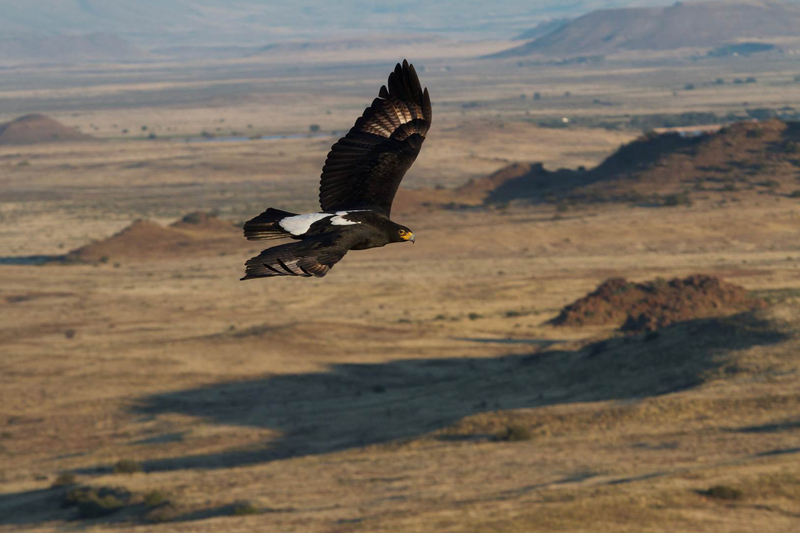Win-win for wind energy and eagles
13 January 2021 | Story Nadia Krige. Photo Gareth Tate. Read time 5 min.
While the rapid uptake of wind energy across the globe offers hope of a transition toward sustainability, this same energy can also present a real threat to soaring birds of prey. Now a new tool offers hope of a win-win solution, allowing developers to rapidly identify the best locations for their wind turbines and also minimise the risk of collision for one special bird of prey.
The Verreaux’s eagle is a charismatic bird of prey that is particularly vulnerable to collisions with wind turbines. It isn’t known if the eagles simply do not see the moving blades, or do not perceive them as a threat, nevertheless the outer tip of turbine blades spin at speeds of up to 290km/hour and collisions with them are fatal. In South Africa, a considerable number of eagles have already been killed at wind farms.
To minimise these collisions, developers usually try to build wind turbines away from areas that are in ‘high-use’ by birds of prey. Typically, this has involved restricting any development within a certain distance of active nest sites. This creates circular exclusion buffers around nest sites, however, eagle space use is not circular and this method has not proved very satisfactory for either developers or conservationists.
The VERA computer model
This situation inspired researchers from the Fitzpatrick Institute of Ornithology, Hawkwatch International and the University of Amsterdam to develop a new tool – the Verreaux’s Eagle Risk Assessment (VERA) model, which offers developers more accurate guidance on where to safely build their turbines.
Tracking of the eagles started 8 years ago, when the first Verreaux’s eagle was fitted with a GPS tracking device.
Published on 5 January 2021 in the British Ecological Society’s Journal of Applied Ecology, VERA is a computer model that was built using data collected by attaching GPS tracking devices onto 15 Verreaux’s eagles across South Africa.
The study shows that by applying this tool, instead of an exclusion buffer, developers can achieve the same level of protection for the eagles but can increase the areas of land available for safe wind energy development by around 20%.
“In short, by using our predictive model to account for habitat use instead of simple buffers around a nest, a greater area of land can be made available for wind energy development without increased mortality risk to raptors,” says Dr Megan Murgatroyd from HawkWatch International and the lead author of the study.
Predicting where and how high eagles will fly
Tracking of the eagles started 8 years ago, when the first Verreaux’s eagle was fitted with a GPS tracking device as part of Murgatroyd’s PhD at the University of Cape Town. The devices were developed at the University of Amsterdam and can provide a record of where and how high the bird is flying up to every 3 seconds.
“Our aim is to allow wind energy to be developed in a more sustainable manner, and to reduce the threat these turbines can pose to this important African species.”
Associate professor Arjun Amar of the Fitzpatrick Institute of African Ornithology and co-author of the study, said “the data that Megan has been able to collect is unparalleled for any eagle in Africa, and has allowed us to build these models”. He added, “Our aim is to allow wind energy to be developed in a more sustainable manner, and to reduce the threat these turbines can pose to this important African species.”
Implementation
It is clear that there is considerable demand for the model, and it has already helped provide guidance on turbine placement for a number of proposed wind farms across the South Africa.
Dr Murgatroyd emphasises, “The best time to run the model is at the very early stages of a project. This way, developers are able to plan their layouts accordingly from the start, instead of having to make major, expensive changes at a later stage.”
Murgatroyd notes that it’s encouraging to see how willing developers have generally been in using VERA and taking up the recommendations voluntarily. “We will now work with Birdlife South Africa to update their guidelines on wind energy and Verreaux’s eagles. This will help to bring the use of VERA into adopted best-practice for Environmental Impact Assessments at all proposed developments which have breeding Verreaux’s eagles.”
 This work is licensed under a Creative Commons Attribution-NoDerivatives 4.0 International License.
This work is licensed under a Creative Commons Attribution-NoDerivatives 4.0 International License.
Please view the republishing articles page for more information.
Research & innovation





































